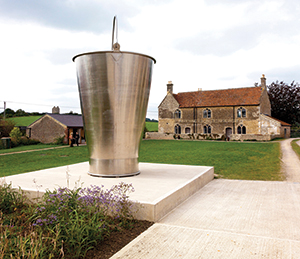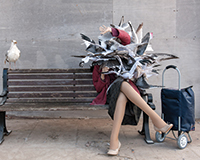 The carousel at the Dismaland Bemusement Park has been spinning gently since early August. Adapted to replace some of the horses with boxes marked “lasagne”, the fairground jolly is attracting radical-chic crowds to Weston-super-Mare at a modest £3 a time.
The carousel at the Dismaland Bemusement Park has been spinning gently since early August. Adapted to replace some of the horses with boxes marked “lasagne”, the fairground jolly is attracting radical-chic crowds to Weston-super-Mare at a modest £3 a time.
Formerly best-known for his graffiti art, Banksy’s north Somerset “austerity theme park” is expected to attract 150,000 visitors by the time the carousel stops spinning on 27 September. Enthusiastic locals estimate it will have made an (unverified and unverifiable) contribution of £7m to the local economy.
Dismaland could do the commercial property market a favour, too. The site (see panel) has a long and appropriately dismal development history. Hopes are high that the Banksy connection will mean art-house prices, if and when North Somerset council sells. The Banksy momentum may also encourage some funky-ironic alternative plans.
For now, that’s all custard pie in the sky. Travel inland to the Somerset villages of Bruton and Babington for a more tangible example of what culture can do for property.
 It’s a year since international art dealer Hauser & Wirth opened a new rural outpost at Durslade Farm, Bruton. Since then, more than 60,000 visitors have called by. Not everyone buys, of course. The art is priced for the international elite – Bruton shares the Hauser & Wirth name with New York and Zurich – but the fine dining and gardens are more affordable.
It’s a year since international art dealer Hauser & Wirth opened a new rural outpost at Durslade Farm, Bruton. Since then, more than 60,000 visitors have called by. Not everyone buys, of course. The art is priced for the international elite – Bruton shares the Hauser & Wirth name with New York and Zurich – but the fine dining and gardens are more affordable.
Down the road, Babington House hotel has become an exclusive private members’ club, the country cousin to London’s Soho House. Celebrities and the ultra-rich are now regulars on the A362 into Frome.
Mike McElhinney, Bath-based partner at Carter Jonas, says both have contributed to a resurgence of the local retail and leisure scenes – with values rising appreciably.
“Babington House has had a huge impact on Frome,” he says. “We’ve seen a number of London-centric businesses open up in the town, very exclusive retailers coming in at a price point we’ve never seen before.”
McElhinney says the 30,000 sq ft of retail space at Catherine’s Hill has been the main beneficiary. Rents have risen from £10 per sq ft to the high twenties, while freehold sales (followed by refurbishments) are now legion.
“This is the tangible effect of the Babington shopper,” he says. “Venues that were struggling on local trade are now going from strength to strength.”
But Somerset’s cultural spin-offs don’t stop at hipster theme parks and high-end shoppers. Just nine miles from Bruton is Worthy Farm, Pilton, home to the Glastonbury Festival – and if you care to journey a little further north to Bristol, there’s Shaun the Sheep’s impact to consider.
Shaun is a West County cultural phenomenon, a home-grown product of the same Bristol-based Aardman Animation stable that gave the world Wallace and Gromit. This summer, two flocks of 70 giant sculpted Shauns went on show in London and Bristol – and Cribbs Causeway’s The Mall hosts the Bristol round-up, Shaun in the City.
While the proceeds go to charity – part of a £5m fund-raising for Bristol Children’s Hospital – there is a serious commercial upside, too. Jon Edwards, CBRE’s centre director at The Mall, says the sheep help pull in visitors and increase dwell times.
“Visitors numbers for the sheep are about 5,000 a day, adding to normal summer footfall of 25,000-30,000, so it’s quite an increase,” he says. “Dwell time is harder to measure, but we know it’s been growing over the last three years. It’s hard to say whether Shaun is responsible, but the effect must be positive.”
Sales figures suggest there has been an ovine uplift. “During last year’s Shaun event, we saw July and August sales up 3% like for like, the best for many years, and that gave us a big base for the crucial final quarter of the year,” says Edwards. “The effect of this kind of event is not immediate. Retail is all about experience.”
The sheep may or may not be coming back for summer 2016. If they don’t, attention will switch to Cribbs Causeway’s new Concorde museum, which could have an even bigger effect on footfall and sales.
If Shaun the Sheep is deemed as being culture, rarely has such a measurable impact been seen on sales figures. However, it often leads to long-term demographic shifts such as those now enjoyed by Bruton and Frome. Either way, the art of regeneration is perfectly at home in the West Country.
Tropicana troubles
Weston-super-Mare’s Tropicana Lido, now home to Banksy’s temporary art exhibition Dismaland, has been a seafront albatross for North Somerset council since it closed 15 years ago.
Henry Boot Developments planned an eight-screen cinema, 90,000 sq ft of shops and leisure and 471 parking spaces in 2007 – but public-sector procurement rules and the credit crunch killed the £48m plan two years later.
New bids for the council-owned site saw both the shortlisted parties pull out. Nightingale Group withdrew in 2010, followed by Wiltshire-based Havard Tisdale, which said it was no longer viable. The council’s insistence that the site was not redeveloped for housing, and must include an all-weather swimming pool, may not have helped the financial appraisals.
A spokesman for North Somerset council said: “I think it is fair to say that if someone came forward with a viable business plan for the site, we would consider it. We have invested a considerable amount in The Bay, a café/restaurant at the front of the Tropicana building, which we are running and which has been very successful.”











